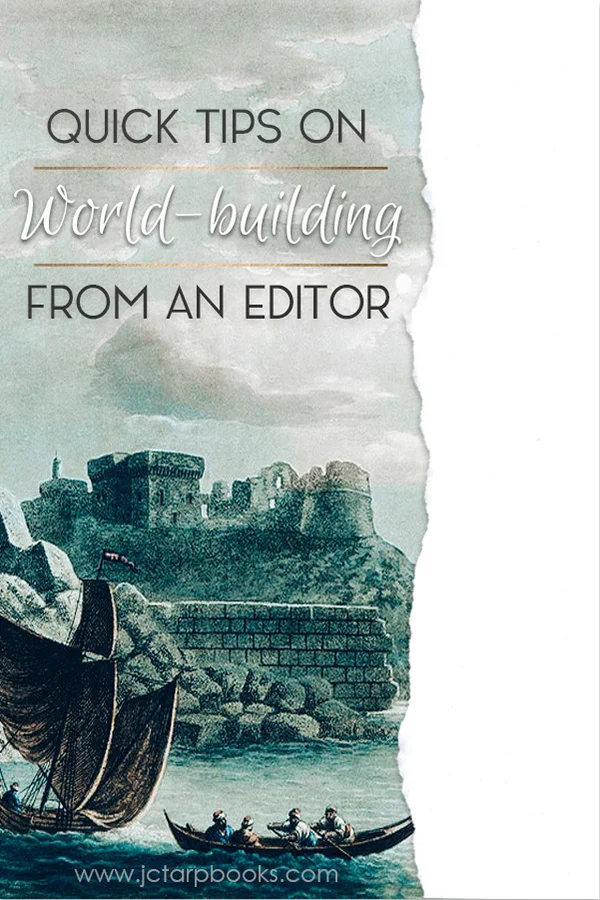World-Building Tips From An Editor
The best kind of editor can look at your work with both a critical eye for detail and as a reader (either in a professional or casual capacity). We love nothing more than getting lost in a story. And that’s the point, right? To make a reader drown in your story? There’s nothing worse than abruptly being pulled out of it for sometimes simple, sometimes complex issues than can be caught before we get our hands on it.
Here’s a few tips about world-building to remember as you write that best-seller or blockbuster.
INFO DUMPS
“Info dumps” make my eyes glaze over faster than I run toward a piece of cake. This is where the writer literally tells us everything there is to know about the setting, background, time-period, characters - main and secondary, or establishes genre all at once. It could be one of those things or all of those things but I immediately lose interest.
While it’s important to set the scene or time and place or introduce our main character, it’s even more important to continuously reveal these details. Don’t give us a first page that you need, like, charts and graphs to follow.
So, a suggestion would be that if you feel the need to just get everything out there at once, do it. If that's how the creativity comes out, by all means; let it flow. But save that work separately and cut it from the book draft. You can then refer to it periodically and sprinkle it throughout the first chapter thereby engaging the reader even more.
CONSISTENCY
Don't forget the world you’ve created - the world the reader now exists in.
For example, if you've written a Sci-Fi adventure set on another planet and mid-way through the book, a character is riding a “motorcycle” - that’s going to pull a reader away. They wouldn’t have motorcycles. Well, unless you set that up by letting us know that they still use some of the old Earth words. But if you do that, then this planet would have to have had refugees or explorers from Earth at one point. Follow the thread. It will only make your story more engaging. But then again, a two-wheeled craft on another planet should look nothing like a motorcycle, right?
You've built the world, now stay in it and give us even more. Push yourself.
RESEARCH
A writer should know everything there is to know about their world before a word is written.
As a reader, we want to be transported. Escape. Whether that’s to present-day Los Angeles, The Hamptons in the 1950s, Texas in the 1920s, an alternate reality, or a realm solely created by you, we want to live there for just a bit. Because ugh life. And we’re trusting you to take us there.
If it’s a “secondary world” such as an historical fantasy based in the Middle Ages, find out what they ate, drank, what the apparel at the time was. How did they wear their hair? How is the caste system set up? What is your world’s history? Create it. Is there magic? Are there different languages? Are you going to invent your own? Are you on Earth?
Know what you’re writing about so it will effortlessly come across to your reader. If you don’t immerse the reader in your world completely, they’ll lose interest.
I expand on this here.
CHARACTERS
Many times the setting is a character in and of itself. But also remember to allow your physical characters to shape the story. They act and interact and move the plot forward within the physical world you’ve created.
Don’t let your world overtake your characters. It’s there to serve them.
FEEL
Don’t get so absorbed with people, places, and things that you forget about the overall feel and atmosphere of your world.
Seeing isn’t the only sense we have and, as a writer, you should incorporate them all to give your reader a richer story. Smells, sounds, tastes. Do these things affect your characters? Use emotions. Set the tone and mood.
A story focused only on sight is flat and one-dimensional and will quickly become boring no matter how kickass it looks.
FLAWS
Real-life is flawed. Humans are flawed. The environment is flawed. Cats are flawed. Not dogs, though, they’re perfect. Your world must reflect this.
In the case of Sci-Fi or paranormal or fantasy, you’re asking a reader to suspend belief while you make up your own rules - they way things look, the government, magic, technology, empires, people, aliens, werewolves, Sasquatch, flying trains. The reader will suspend their beliefs for you, but they will struggle with it unless you make it real. And real means flawed. Nothing is perfect. Not even utopias.
Maybe things appear a certain way on the surface but once we get a closer look, things are quite different. That glorious king sitting on his throne that all the citizens adore for being generous and kind? Perhaps he’s only sitting there because his ancestors waged a war and stole it. Or, you know, he killed his brother. Not so kind, huh? Is magic only realized in persons with at least one magical parent yet one or possibly many more characters don’t have them? Is a hacker-proof technology hacked?
Corruption, consequences, external elements - anything can be a flaw. Make it subtle, but make your world flawed.
If you remember these tips as you’re building your world, the reader (and editor) will stay right where you want them - engrossed in your story.











